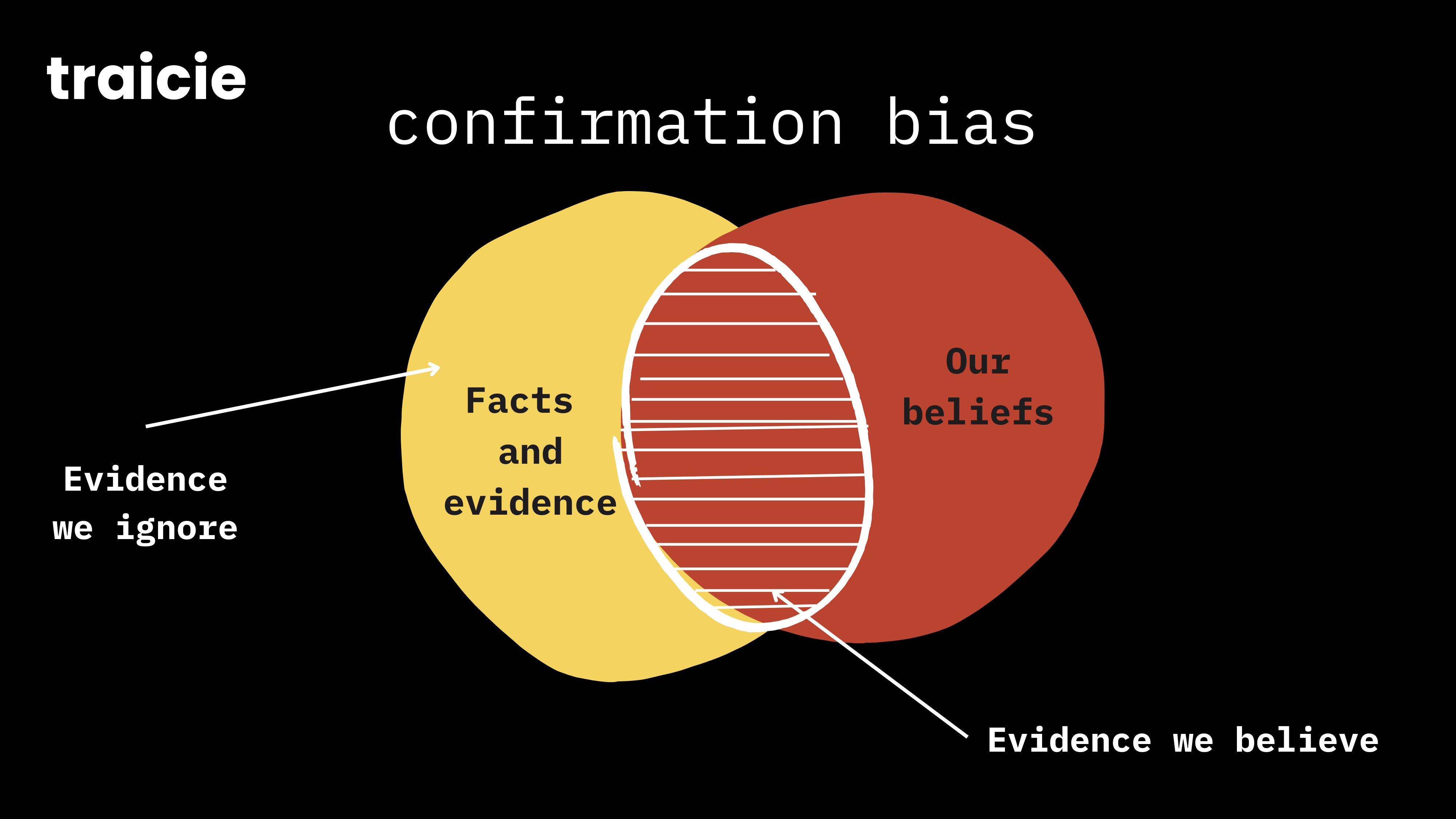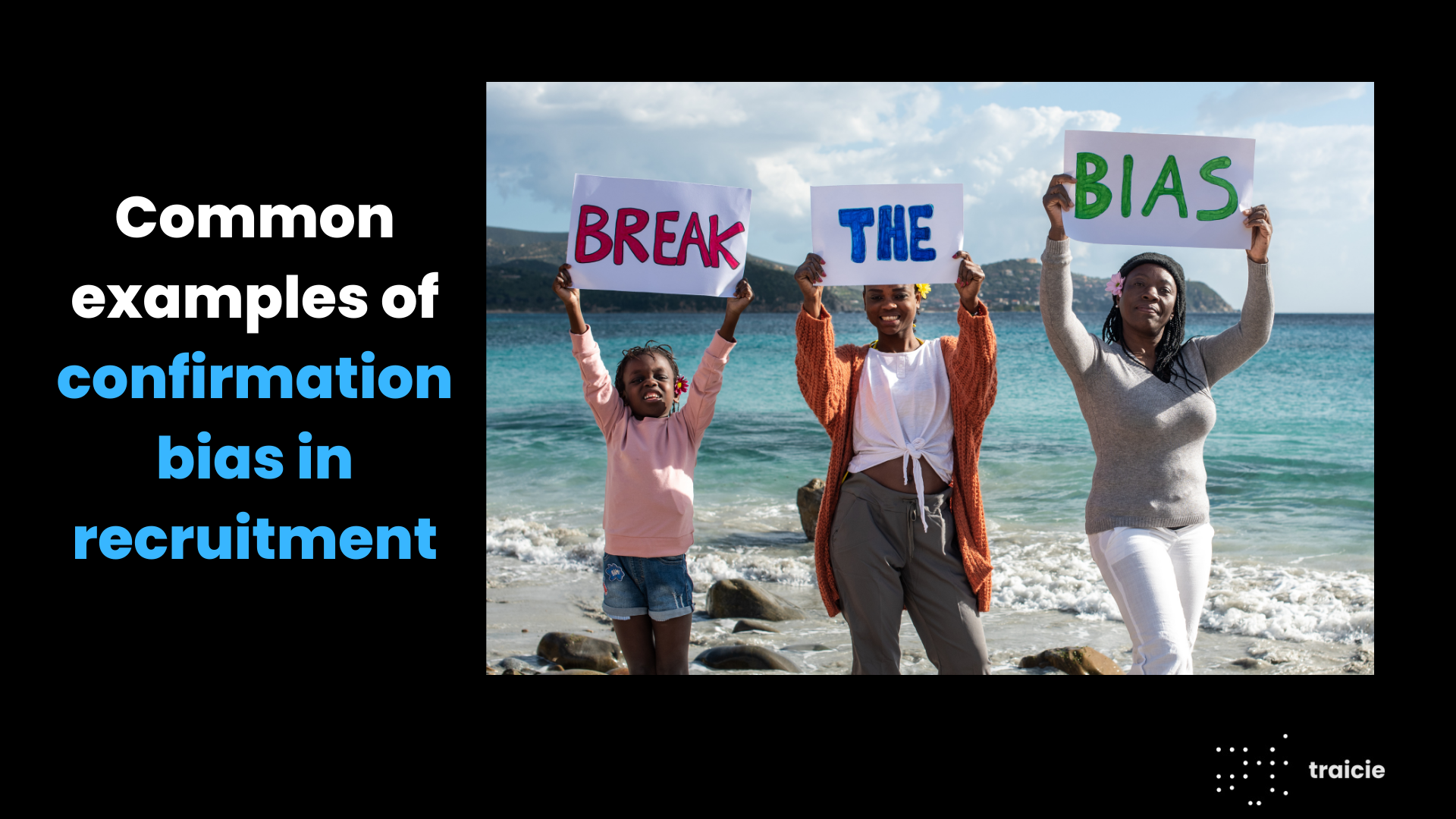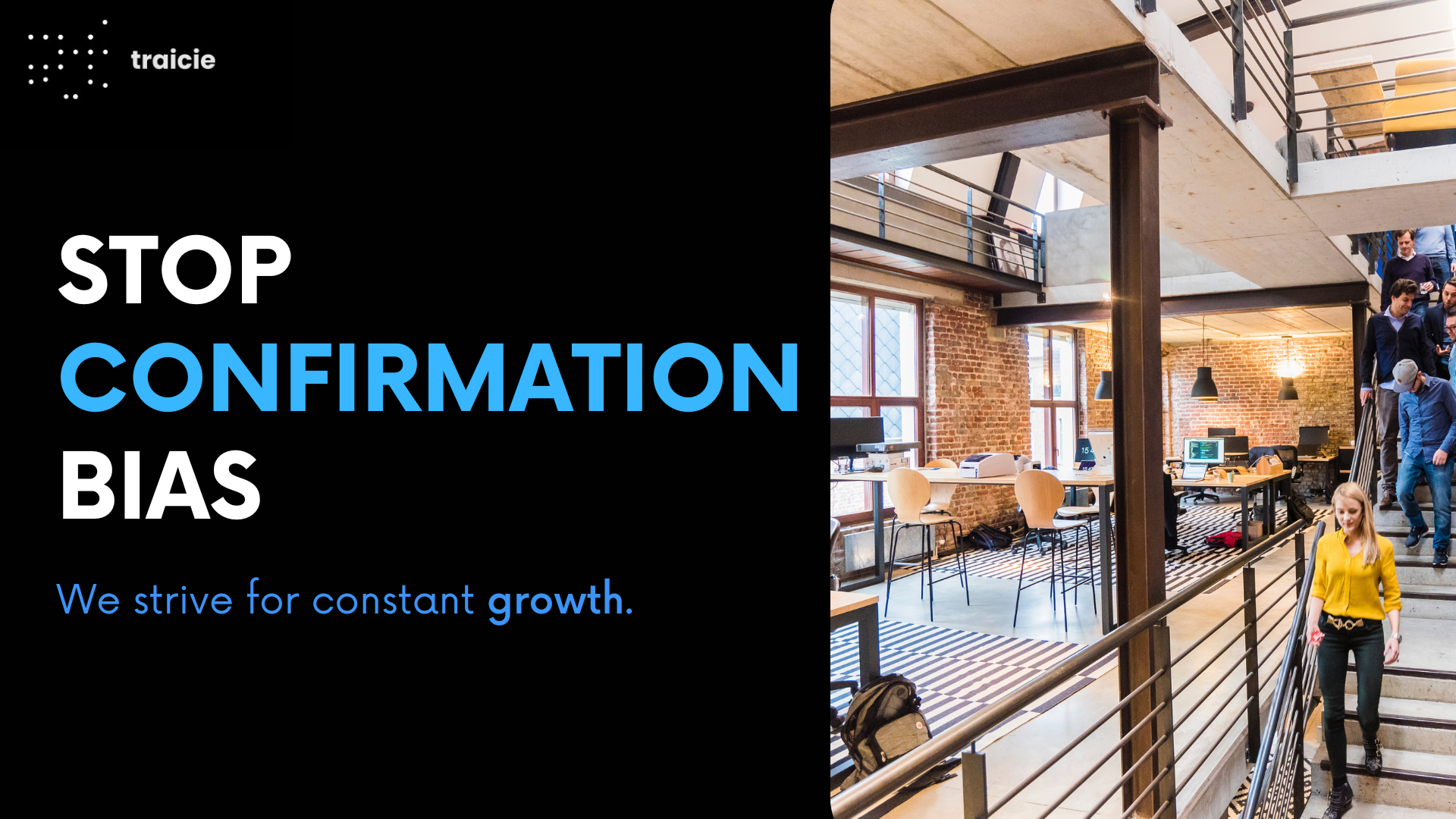Avoiding bias is impossible. Unconsciously, we make certain choices daily. People naturally tend to seek information confirming their beliefs while ignoring everything that contradicts them. To overcome these biases, it is essential to become aware of them. Especially in recruitment, avoiding bias and hiring candidates in a fair and equal environment is vital. Therefore, it is essential to stay reflective and critical to avoid biased decisions and be aware of one’s biases.
| >>> You might interested in Free Personality Survey for Career to pinpoint what makes you unique.
Want to make sure you avoid bias in your initial screening, use screening tools such as traicie to provide you with unbiased data
What is Confirmation Bias?
Confirmation bias is seeking information that confirms your preexisting beliefs or opinions.

The American Psychological Association defines confirmation bias as: “The tendency to gather evidence that confirms preexisting expectations, typically by emphasizing or pursuing supporting evidence while dismissing or failing to seek contradictory evidence.”
When looking for a new employee, it’s easy to fall into the trap of only considering candidates who confirm your beliefs about the perfect candidate for the job. For example, if you’re looking for a salesperson, you might only consider candidates with a lot of sales experience. However, this can lead to overlooking great candidates who might not have as much sales experience but have other qualities that would make them successful in the role.
To avoid confirmation bias in hiring, it’s essential to keep an open mind and consider all qualified candidates for the job, regardless of their background or experience. Try to look at each candidate objectively and find out what they could bring to the role. This will help you find the best possible candidate for the job and avoid making any mistakes in your hiring decision.
|>>>>> Want to make sure you avoid bias in your initial screening, use screening tools such as traicie to provide you with unbiased data
How does confirmation bias happen?
The American Psychological Association has found that people naturally want to avoid the problems of being open to new ideas. We also tend to seek confirmation and support that our opinions are correct just because we want them to be. But there are also other ideas out there.
Some say that confirmation bias lets us process information faster because we can rely on ideas we already have. Considering how many resumes recruiters have to look through, this idea might not be idealistic. No matter why it happens, the results of confirmation bias are still wrong.
Common examples of confirmation bias in recruitment
Confirmation bias can appear in many ways during the hiring process. Here are some of the most common ones that we’ve seen.
1. Cultural confirmation bias
Sometimes, hiring managers have a bias against a candidate because of how they think their culture should be. People get cultural biases from how they were raised or how society affects them. Let’s say a hiring manager comes from a culture where tattoos are associated with violence and sees a candidate’s tattoo on their social media profile. They may be affected by confirmation bias, where the hiring manager looks for signs of conflict between the candidate and their social beliefs.
2. Confirmation bias based on gender
Suppose a hiring manager thinks a particular gender is better for a job. In that case, they are likelier to ignore professional evidence and look for information that backs up what they already think. Let’s say there’s an opening on the sales team, and the top two candidates are men and women with the same skills and experience. A test of job-related skills shows that women do better than men. But the manager chooses the men because men seem to “fit” the role better.
|>>>>> Want to make sure you avoid bias in your initial screening, use screening tools such as traicie to provide you with unbiased data

This is an example of gender-based confirmation bias. The hiring manager is unconsciously sticking to the old stereotype of the salesman and ruling out the woman, even though she has shown she can do the job just as well as the man, if not better.
3. Trigger confirmation bias
Confirmation bias can happen when you have experiences connected to a place or thing. Let’s say you see a candidate from a school or neighbourhood where you suffered a negative experience. You don’t have to focus directly on the candidate, but you can ask pointed questions to confirm your bias. You’ve been upset by something in their past, and you’ve let that change how you see the candidate.
How To Avoid Confirmation Bias
Confirmation bias is the tendency to search for, interpret, or remember information in a way that confirms one’s preconceptions or hypotheses. This can lead to wrong decisions in hiring. There are a few ways to avoid confirmation bias when hiring:
Confirmation bias

Confirmation bias
- Be aware of your biases and try to set them aside when making decisions.
- Make sure to consider all candidates equally. Don’t let your preconceptions about a candidate colour your evaluation of their qualifications.
- Seek out multiple sources of information about candidates. Don’t just rely on your impressions. Talk to references, colleagues, and other people who know the candidate well.
- Take your time when making hiring decisions. Don’t rush into a decision just because you need to fill a position quickly.
|>>> Read more: Cognitive Biases in Recruitment Process, How to avoid it?
Case Study
Company A wants to hire a consultant to produce podcasts. They already did some research and found a few potential candidates. They will likely be biased in favour of the candidates they have already shortlisted. When the recruiter goes through the applications, this person will look for reasons to confirm his bias. Here, the recruiter may overlook qualifications or experience that would disqualify a candidate if it does not fit their preconceived notions.
As a result, the recruiter may hire someone less qualified or experienced than other applicants who applied for the job. It is essential to keep an open mind when reviewing applications to avoid this type of confirmation bias.
Try to look at each candidate objectively and consider their qualifications and experience. Do not allow your preferences to influence your hiring decisions.
|>>>>> Want to make sure you avoid bias in your initial screening, use screening tools such as traicie to provide you with unbiased data
What did this recruiter do wrong in the hiring process?
- Based on previous research, the recruiter likely had a preconceived notion that the candidate was the most qualified for the job.
- The recruiter unconsciously looked for evidence to confirm this belief rather than looking at the candidate objectively.
- As a result of confirmation bias, the company likely missed out on hiring a more qualified candidate.
- Resources and time were wasted on the hiring process.
This is why it’s essential to be aware of confirmation bias and ensure that it doesn’t influence your decisions.
What should the recruiter do instead?
- Look at the candidate’s qualifications objectively instead of relying on their gut feeling.
- Consider whether the candidate is a good fit for the job rather than just whether you like them.
- Be aware of your biases and try to counteract them.
- Pay attention to red flags instead of assuming that the candidate is nervous.
- Take more time to decide instead of rushing into it.
Do you know that traicie’s sourcing tools for recruiters can help the hiring team with culture-based hiring but also improves the strategic, operational value of the recruiting process :
- Cost of a job board – Reduce annual spending on job boards
- Cost of HR tools – Reduce the cost of surveys and assessment tools
- Recruitment costs – Reduce selection costs
- Internal mobility – Fill more skilled jobs with internal staff
- Time to hire – Reduce the number of days a role goes unfilled
- Salary costs – Reduce overall salary costs
- Attrition – Reduce the rate of turnover
- Recruitment cost – Reduce the general recruitment cost